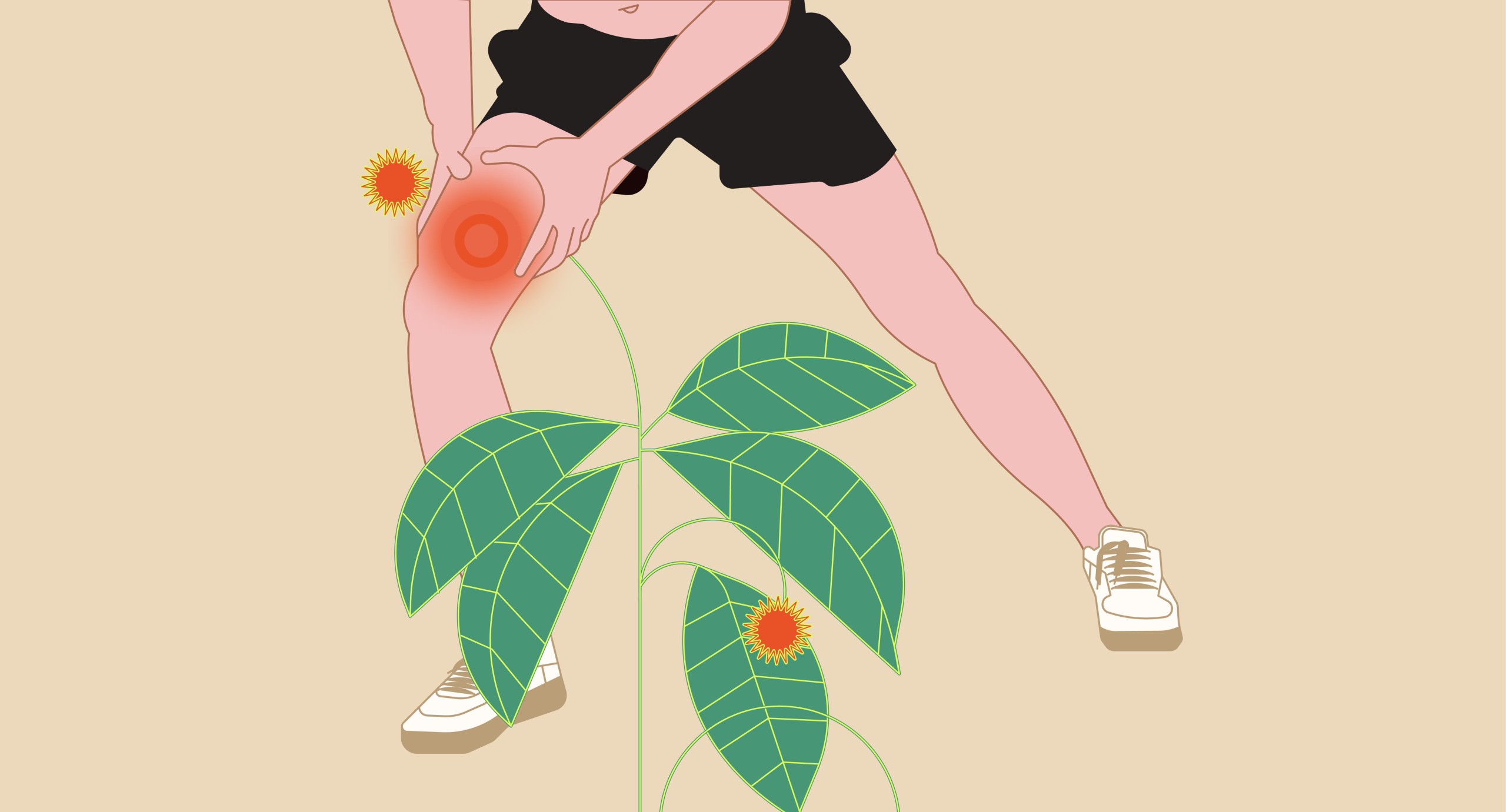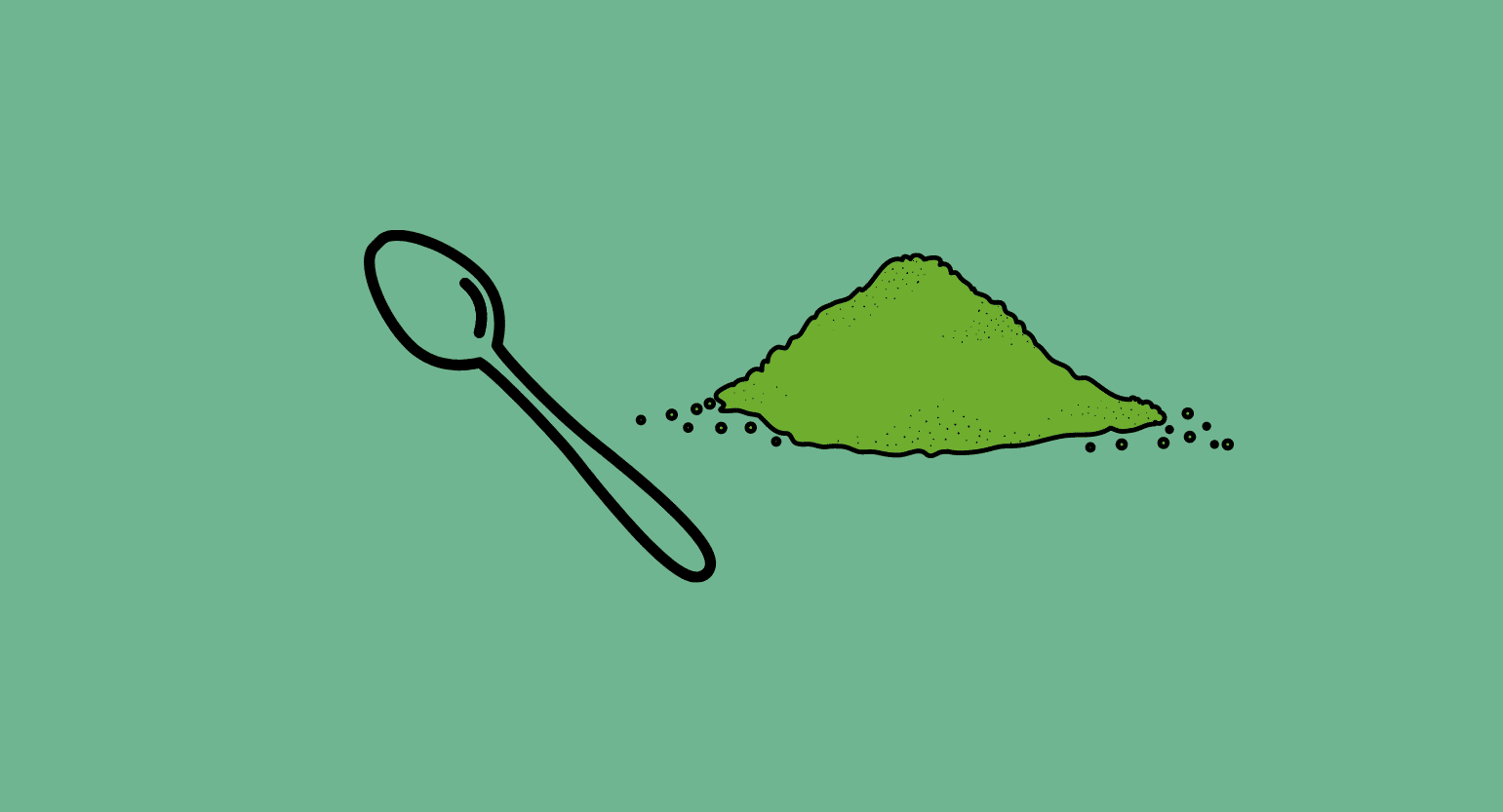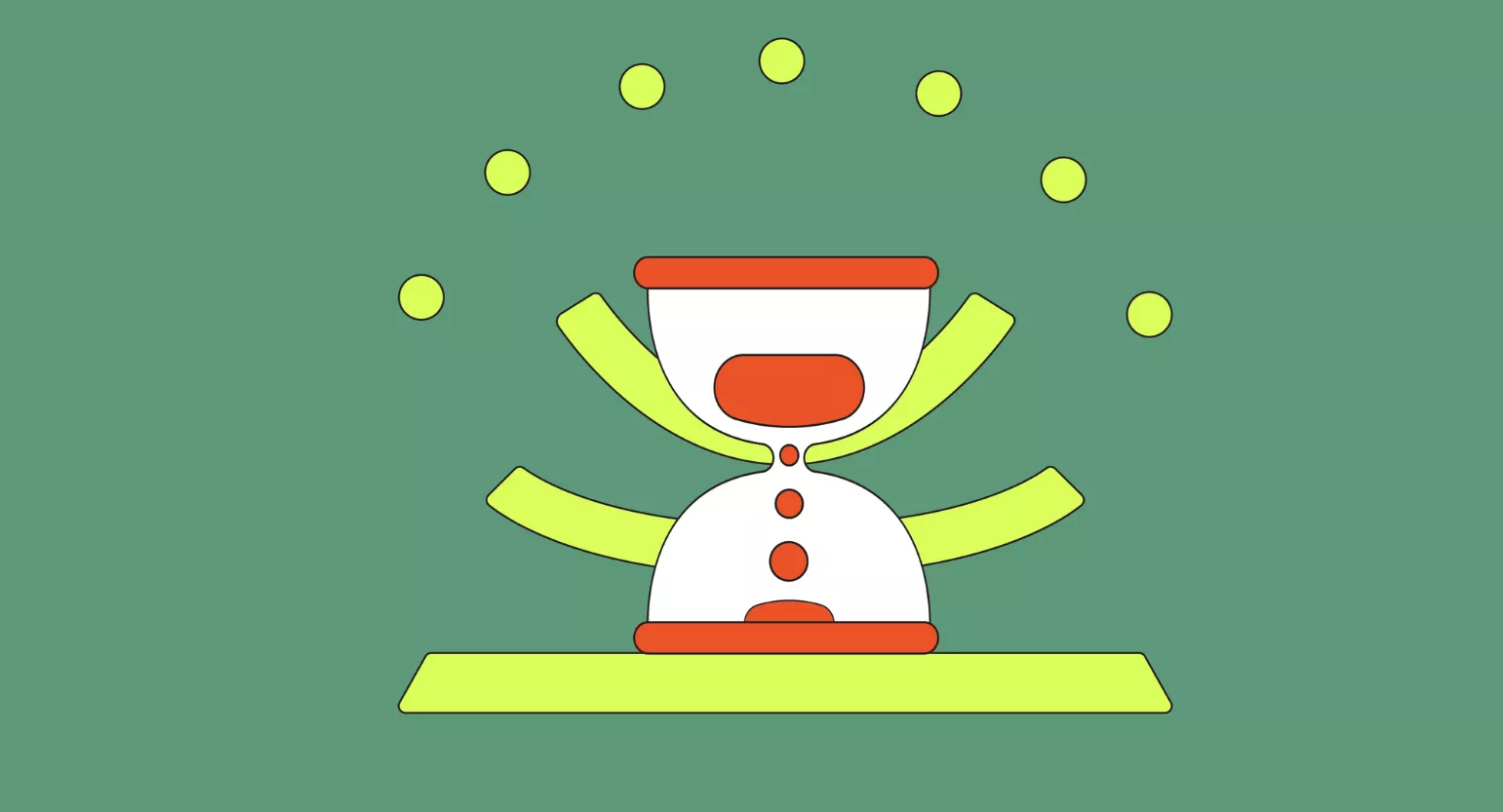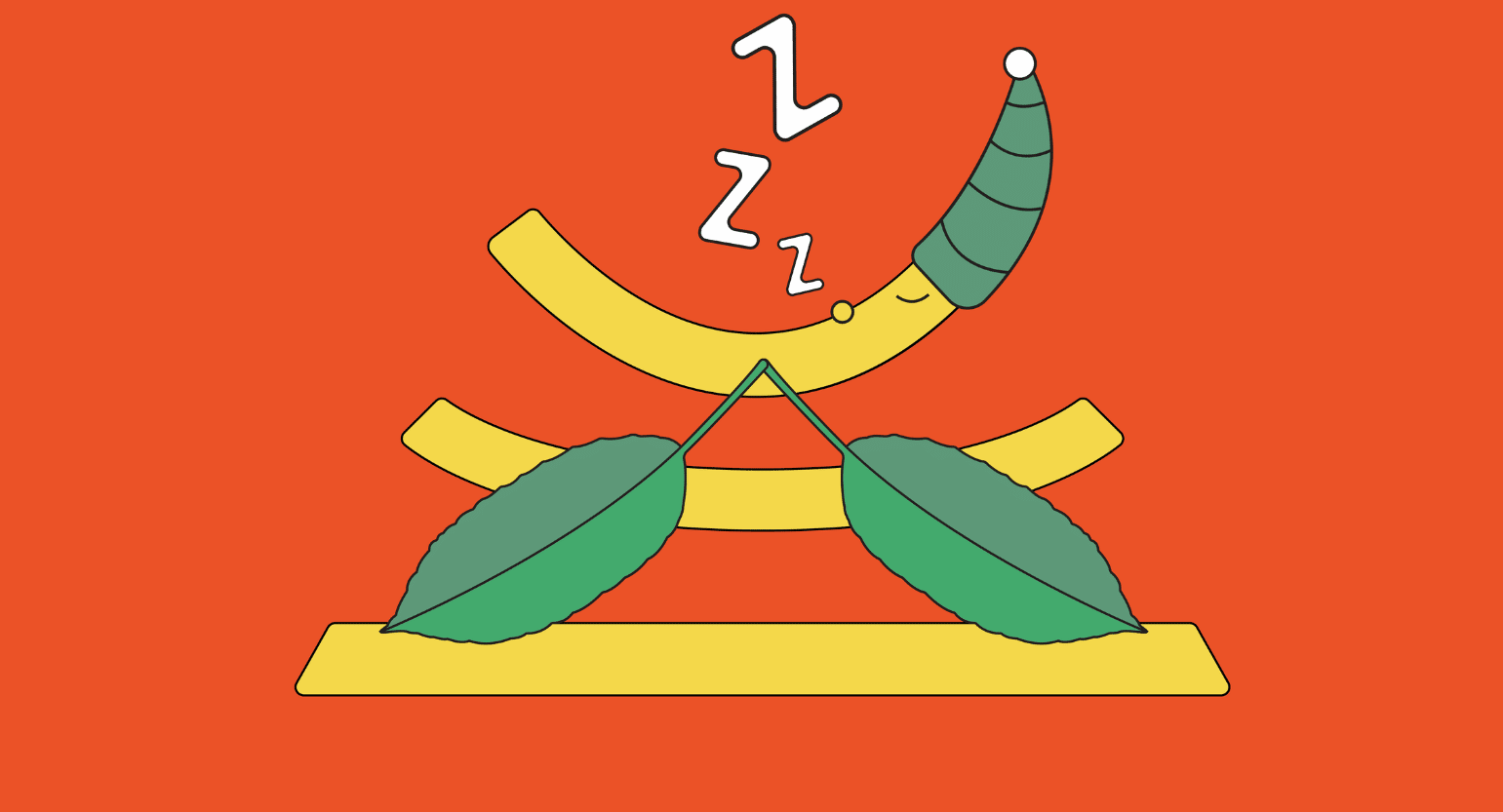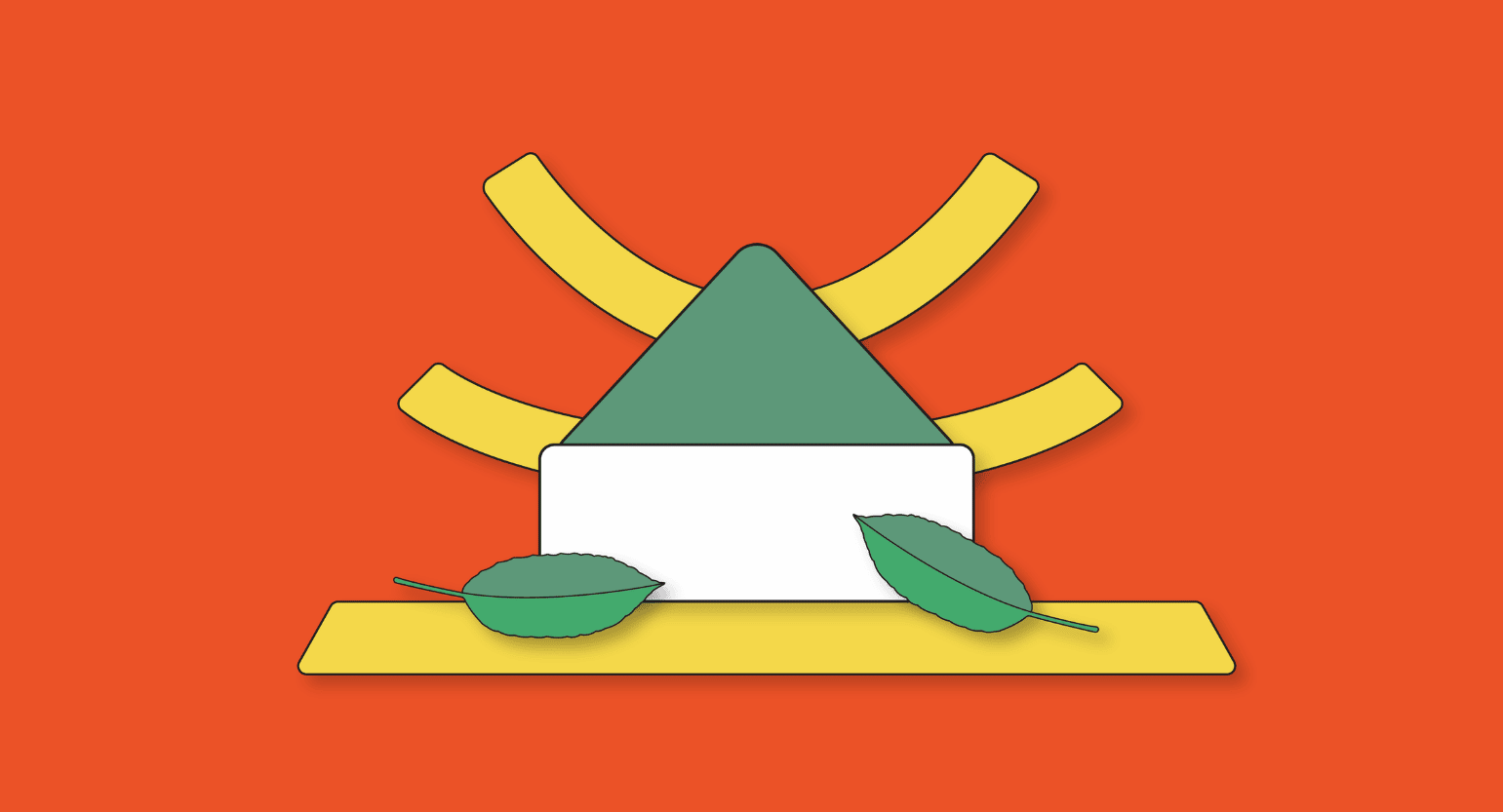What Is Kratom?
Kratom (Mitragyna speciosa) is a Southeast Asian herb with natural pain-relieving properties. It’s native to Thailand and Indonesia and has been used to treat pain, insomnia, and mood disorders for centuries in traditional medicine.
Kratom leaves are dried and ground into a fine powder. It’s most commonly mixed into water or brewed into tea, though there are other ways to use kratom powder.
Three main kratom strains are denoted by the color of the veins that run through the leaves. Red kratom is generally considered relaxing and good for pain, white kratom is usually energizing, and green strains offer stimulation and sedation.
Can Kratom Help With Muscular Pain?
Many people use kratom to treat all sorts of pain, including muscular pain. Kratom works by blocking pain signals, effectively treating pain regardless of its source [1]. It interacts with the body’s opioid receptors to change the neurochemical response to stimuli, effectively deadening and relieving pain.
Note that kratom is not classified as an opioid even though it interacts with opioid receptors and is unlikely to cause an overdose.
Kratom contains two primary alkaloids — mitragynine and 7-hydroxymitragynine — that confer most of its analgesic effects. Of the two, 7-hydroxymitragynine is considered the more potent pain reliever responsible for the bulk of kratom’s pain-reducing effects.
Besides blocking pain signals, kratom also relieves muscle tension, making it especially good for treating muscular pain from injuries and tight muscles.
Kratom also modulates neurotransmitter levels, indirectly affecting pain by altering our perception. We explore kratom’s impact on neurotransmitters more in-depth below.
Also see: 6 Easy Stretches for Pain Relief.
Kratom, Dopamine, & Muscular Pain
One of the neurotransmitters kratom interacts with is dopamine. Research indicates that kratom changes dopamine levels in the central nervous system (CNS) and affects how dopamine is absorbed [2]. Dopamine doesn’t directly control pain levels but helps determine our reaction to pain over time.
You might think of dopamine as a pleasure chemical, but it’s more of a motivation chemical. It regulates our response to external stimuli, conditioning our behavior to minimize discomfort and maximize pleasure.
Kratom helps train the body to avoid painful actions and manage them more effectively by altering dopamine levels. This means that it may help people with chronic conditions and long-term pain deal with their discomfort more easily and maintain their normal activity levels.
Suggested Reading: Is Pain Really Necessary? Yes — Here’s Why & What You Can Do About It
Kratom, Serotonin, & Muscular Pain
Kratom also affects serotonin levels, leading to another indirect influence on pain perception. Serotonin is one of the most important neurotransmitters, playing a vital role in cognition, learning, memory, and mood.
Researchers think that kratom affects serotonin absorption, effectively making it more potent [3]. Doctors and psychologists often prescribe serotonin treatments for patients with depression, anxiety, and other mood orders to help stabilize their mental state. Kratom has a similar effect, changing a person’s outlook and helping them avoid pain-related depression.

Best Kratom Strains for Relieving Muscular Pain
The best kratom strains for treating muscular pain are typically those highest in 7-hydroxymitragynine. Unfortunately, finding a strain’s alkaloid content isn’t always easy, so your best bet is to stick with red strains since they usually have higher 7-hydroxymitragynine concentrations than other kratom strain colors.
Most reputable kratom vendors publish third-party testing results, and sometimes those reports contain a breakdown of a strain’s alkaloid content. Unfortunately, not all lab reports have alkaloid information.
Instead of complete lab results, below are some popular strains that are usually safe bets for people looking to relieve muscular pain.
Red Bali
Red Bali is a staple in most experienced kratom users’ repertoire. It’s a medium-strength red strain that’s good for relaxation and relieving mild to moderate pain. Some users with severe muscular pain may find Red Bali too weak, but it’s often a good place to start, even if it doesn’t eliminate your pain.
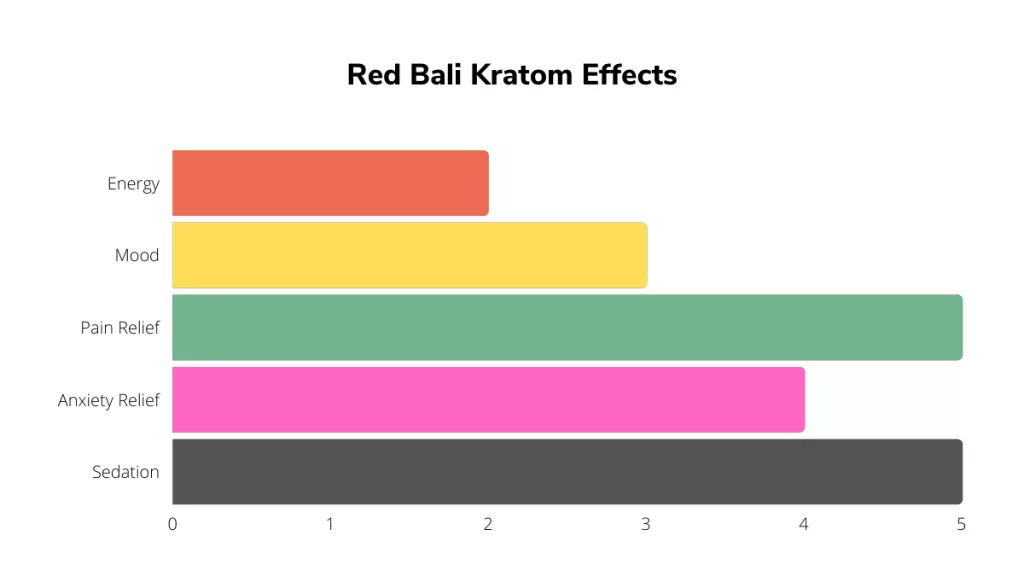
→ Find This Strain on VIP Kratom.
Red Maeng Da
Red Maeng Da is probably a better strain for people with more intense muscular pain since it’s considerably more potent than Red Bali. All varieties of Maeng Da are incredibly potent, and the red strain is highly regarded as one of the most powerfully relaxing strains available. Its pain-relieving capabilities are hard to beat, and many users say that no strain is better for relieving tension.
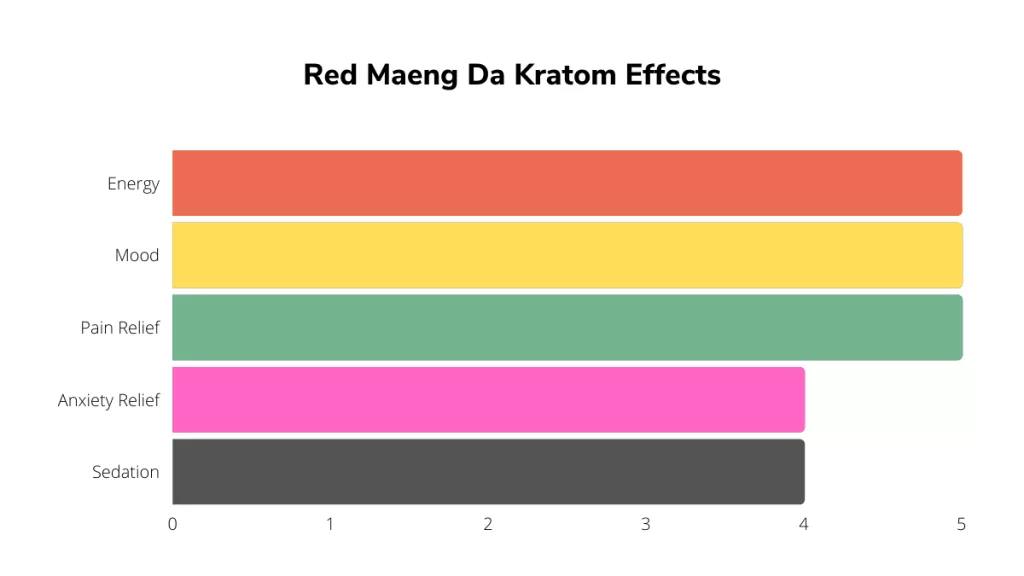
→ Find This Strain on Star Kratom.
Red Borneo
Red Borneo is closer to Red Bali in strength but might be slightly more relaxing, depending on who you ask. It’s a solid choice for treating general pain but is especially good for alleviating muscular pain since it is a more relaxing strain. Everyone reacts to different strains differently, so trying Red Borneo is worth it, even for people who find Red Bali lacking.
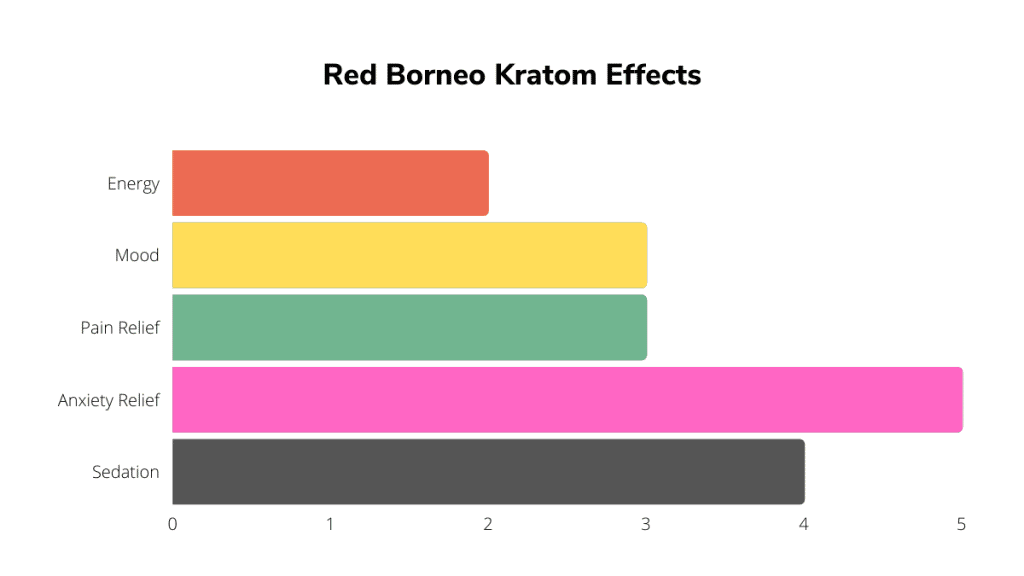
→ Find This Strain on Kona Kratom.
Risks of Using Kratom for Muscular Pain Relief
Kratom is considered safer than powerful prescription medications like opioids and muscle relaxers, but it still comes with some risks.
The most common side effects of using kratom include the following:
- Confusion
- Constipation
- Diarrhea
- Dizziness
- Headaches
- Nausea
- Short-term memory loss
- Vomiting
Some people also report anxiety and panic attacks, although these reactions are less common.
More problematic is kratom’s potential for addiction. Even though kratom is not an opioid, it can still be habit-forming, and people who don’t follow the guidelines for responsible use risk forming a dependence.
Experts recommend limiting weekly kratom intake to fewer than five days and taking at least one week off after one to two months of regular use. Prolonged lethargy is the number one sign that your body needs a break from kratom. Listening to your body and limiting your kratom consumption is vital for using kratom to relieve muscular pain.
Is It Safe to Take Kratom With Other Pain Medication?
Combining kratom with other pain medications is not a good idea. This is even more true with opioids and other painkillers.
Drug interactions can be dangerous, especially when a relatively unstudied substance like kratom is involved. Kratom slows bodily functions and is psychoactive, making it unsafe to combine it with other drugs or prescription medication.
The situation is more complicated than it might seem because many underlying conditions can cause muscle pain. Muscle pain can be treated with many different drugs, depending on the pain’s root cause.
Below are some comparisons between kratom and several common drugs used to relieve muscular pain.
Kratom vs. Valium for Muscular Pain
Valium is a benzodiazepine, a class of muscle-relaxing drugs used to treat spasticity, anxiety, alcohol withdrawal, and some types of seizures. It’s used to treat muscular pain from tight muscles, as this is often the case when people “throw their back out.”
Kratom and benzodiazepines make a dangerous combination — never use the two together.
Valium is considered significantly more effective for tension-based muscle pain, although it also comes with higher risks. It can be incredibly addicting, and long-term use has been linked to liver and kidney damage. According to user reports, kratom can relieve muscle tension, but the effect is weaker than Valium.
Suggested Reading: Can Kratom Help With Benzo Withdrawal?
Comparing Valium & Kratom:
| 🍃 kratom | 💊 Valium | |
| Availability | Unrestricted | Prescription-Only |
| Natural or Synthetic? | Natural | Synthetic |
| Active Ingredient | Mitragynine, 7-hydroxy-mitragynine, & other plant-based alkaloids | Diazepam |
| Indications | Energy & concentration, chronic pain, opiate withdrawal, anxiety, & sleep | Anxiety, muscle spasms, seizures, alcohol withdrawal |
| Dosage | 2-12 grams per day | 6-8 mg per day |
| Common Side Effects | Nausea, vomiting, lethargy, dizziness, anxiety, brain fog, constipation | Tiredness, weakness, difficulty balancing, confusion, depression, headache, blurry vision |
| Level of Risk | Low-Moderate | High |
| Risk of Addiction | Moderate | High |
| Cost | $10 – $20 an ounce (~30 grams) | $150-$200 for thirty 5 mg capsules |
Kratom vs. Cymbalta for Muscular Pain
Cymbalta is a serotonin and norepinephrine reuptake inhibitor (SNRI) used to treat anxiety, depression, nerve pain, and long-term muscle pain. It is incredibly addictive and should only be used to treat muscular pain rarely.
Kratom is considered a better option for muscle pain when the pain is not long-lasting. Cymbalta has a much higher chance of addiction and is mainly used to treat anxiety and depression. However, in extreme cases where muscle pain lasts for more extended amounts of time, Cymbalta can be an excellent temporary option.
Kratom and SNRIs have a high risk of interaction. Don’t use them together without talking to your doctor.
Comparing Cymbalta & Kratom:
| 🍃 Kratom | 💊 Cymbalta | |
| Availability | Unrestricted | Prescription-Only |
| Natural or Synthetic? | Natural | Synthetic |
| Active Ingredient | Mitragynine, 7-hydroxy-mitragynine, & other plant-derived alkaloids | Duloxetine |
| Indications | Boost energy & focus, chronic pain, opiate withdrawal, anxiety, & sleep | Depression, anxiety, fibromyalgia, diabetic nerve pain, long-term muscular pain |
| Dosage | 2-12 grams per day | 30-60 mg per day |
| Common Side Effects | Nausea, vomiting, lethargy, dizziness, anxiety, brain fog, constipation | Nausea, headache, dry mouth, tiredness, insomnia, constipation, dizziness, anxiety, palpitations |
| Level of Risk | Low-Moderate | High |
| Risk of Addiction | Moderate | High |
| Cost | $10 – $20 an ounce (~30 grams) | $250-$300 for thirty 60 mg capsules |
Kratom vs. Celebrex for Muscular Pain
Celebrex is a prescription non-steroidal anti-inflammatory drug (NSAID) used to treat pain and inflammation. Doctors often prescribe Celebrex to treat rheumatoid arthritis or osteoarthritis, but it is sometimes used to relieve short-term muscle pain.
Kratom and Celebrex can both be used to treat short-term muscle pain from strains and tears, but neither is a good option for long-term use. Kratom has the additional benefit of relaxing muscles, which many people find helpful. However, Celebrex is generally considered a stronger pain-reliever than kratom, which makes choosing one over the other dependent on the specific kind of muscle pain.
There’s a mild to moderate risk of side effects when using kratom with NSAIDs. Talk with your doctor before combining them.
Comparing Celebrex & Kratom:
| 🍃 kratom | 💊 Celebrex | |
| Availability | Unrestricted | Prescription-Only |
| Natural or Synthetic? | Natural | Synthetic |
| Active Ingredient | Mitragynine, 7-hydroxy-mitragynine, & other plant-derived alkaloids | Celecoxib |
| Indications | Boost energy & focus, chronic pain, opiate withdrawal, anxiety, & sleep | Muscle pain, arthritis, ankylosing spondylitis, menstrual cramps |
| Dosage | 2-12 grams per day | 400-600 mg per day |
| Common Side Effects | Nausea, vomiting, lethargy, dizziness, anxiety, brain fog, constipation | Headaches, upset stomach, respiratory infections, diarrhea, rash, swelling |
| Level of Risk | Low-Moderate | High |
| Risk of Addiction | Moderate | Low |
| Cost | $10 – $20 an ounce (~30 grams) | $350-$400 for thirty 200 mg capsules |
How Common is Muscular Pain?
Muscular pain is widespread in the computer age. Sitting at a desk for eight hours per day creates tight muscles that cramp up, causing pain and discomfort. Unbalanced muscles from leading a sedentary lifestyle can also cause problems for weekend warriors since people are more likely to injure themselves when they’re tight from sitting all week.
Acute injuries are also unavoidable, even in people who don’t lead overly active lives. Muscle tweaks and strains are a virtually guaranteed part of life, making managing muscle pain an unfortunate skill people must develop. Treating muscle pain depends on accurately determining the cause, which requires knowing the signs and symptoms.
Signs & Symptoms of Muscular Pain
There can be many muscular pain symptoms, depending on what’s causing the pain. Strains, tears, and cramps usually manifest as localized pain that worsens with movement. People typically complain of stabbing pains with activity and dull, throbbing pain at rest when dealing with muscle pain.
Muscle pain can also be caused by nerve conditions that cause painful involuntary muscular contractions. Treating this kind of muscle pain requires a different approach than treating acute injuries.
Common Treatments for Muscular Pain
The most common treatment for muscle pain from strains and other acute injuries is rest. Over-the-counter pain medication like Advil or Tylenol can help make people more comfortable while recovering.
Some doctors subscribe to the RICE protocol, an acronym that stands for rest, ice, compression, and elevation. Icing should be in short bursts for 10-15 minutes at a time, and compression should be applied by a medical professional to ensure it isn’t too tight.
Some muscle pain may not get better and could require surgery. Usually, there is little question whether an injury requires surgery since cases that warrant surgical intervention are often unbearably painful and impossible to endure.
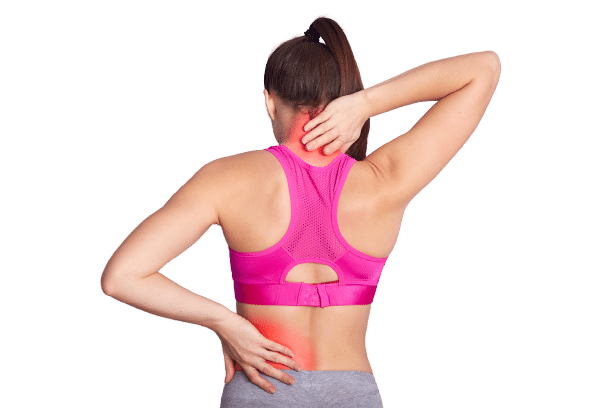
For chronic pain, some people respond well to physical therapy. A trained physical therapist can assess your condition and design a tailored exercise and stretching program that will help reduce your pain and insulate you from future pain. Physical therapy takes time, so patience is essential if you want to see results.
Some people find relief through alternative medicine like acupuncture and chiropractors, although there is no clinical evidence that these treatments are effective. However, they’re generally considered low-risk options, making them worth trying when other methods fail to make a difference.
Also see: Hot vs. Cold Treatments For Pain (& Other Methods To Try).
Key Takeaways: Can Kratom Help With Muscular Pain?
Kratom can help with some forms of muscular pain but isn’t always the best option.
According to user reports, it’s very effective at reducing pain from tight muscles or minor injuries like mild strains. Other medications are often more effective for more severe injuries that require more time to heal and cause more severe pain. However, stronger medication usually comes with more severe side effects, making it a matter of weighing costs versus benefits.
Kratom has its side effects, although these are usually not as serious as the troubling side effects of many prescription pain-relievers. One more insidious effect of using kratom is addiction, so users are cautioned to limit their consumption and take regular breaks to avoid developing dependence.
One area where kratom trounces the competition is price. Kratom is often ten times cheaper than prescription medication, making it an attractive option for people who can’t afford to foot the bill for expensive prescriptions.
Before taking kratom for muscular pain, everyone should consult a doctor since it can have potentially dangerous interactions with other medications.
- Eastlack, S. C., Cornett, E. M., & Kaye, A. D. (2020). Kratom—Pharmacology, clinical implications, and outlook: a comprehensive review. Pain and therapy, 9(1), 55-69.
- Stolt, A. C., Schröder, H., Neurath, H., Grecksch, G., Höllt, V., Meyer, M. R., … & Becker, A. (2014). Behavioral and neurochemical characterization of kratom (Mitragyna speciosa) extract. Psychopharmacology, 231(1), 13-25.
- Johnson, L. E., Balyan, L., Magdalany, A., Saeed, F., Salinas, R., Wallace, S., … & Grundmann, O. (2020). Focus: Plant-based Medicine and Pharmacology: The Potential for Kratom as an Antidepressant and Antipsychotic. The Yale Journal of Biology and Medicine, 93(2), 283.

